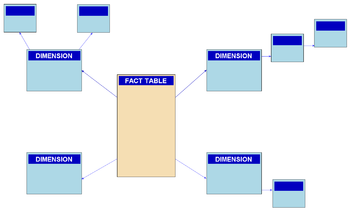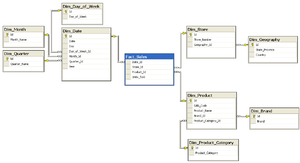
Snowflake schema
Encyclopedia

Computing
Computing is usually defined as the activity of using and improving computer hardware and software. It is the computer-specific part of information technology...
, a snowflake schema is a logical arrangement
Logical schema
A Logical Schema is a data model of a specific problem domain expressed in terms of a particular data management technology. Without being specific to a particular database management product, it is in terms of either relational tables and columns, object-oriented classes, or XML tags...
of tables in a multidimensional database such that the entity relationship
Entity-relationship model
In software engineering, an entity-relationship model is an abstract and conceptual representation of data. Entity-relationship modeling is a database modeling method, used to produce a type of conceptual schema or semantic data model of a system, often a relational database, and its requirements...
diagram resembles a snowflake
Snowflake
Snowflakes are conglomerations of frozen ice crystals which fall through the Earth's atmosphere. They begin as snow crystals which develop when microscopic supercooled cloud droplets freeze. Snowflakes come in a variety of sizes and shapes. Complex shapes emerge as the flake moves through...
in shape. The snowflake schema is represented by centralized fact table
Fact table
In data warehousing, a fact table consists of the measurements, metrics or facts of a business process. It is often located at the centre of a star schema or a snowflake schema, surrounded by dimension tables....
s which are connected to multiple dimensions
Dimension (data warehouse)
In a data warehouse, a dimension is a data element that categorizes each item in a data set into non-overlapping regions. A data warehouse dimension provides the means to "slice and dice" data in a data warehouse. Dimensions provide structured labeling information to otherwise unordered numeric...
.
The snowflake schema is similar to the star schema
Star schema
In computing, the star schema is the simplest style of data warehouse schema. The star schema consists of one or more fact tables referencing any number of dimension tables...
. However, in the snowflake schema, dimensions are normalized into multiple related tables, whereas the star schema's dimensions are normalized with each dimension represented by a single table. A complex snowflake shape emerges when the dimensions of a snowflake schema are elaborate, having multiple levels of relationships, and the child tables have multiple parent tables ("forks in the road"). The "snowflaking" effect only affects the dimension tables and NOT the fact tables.
Common uses
Star and snowflake schemas are most commonly found in dimensional data warehouseData warehouse
In computing, a data warehouse is a database used for reporting and analysis. The data stored in the warehouse is uploaded from the operational systems. The data may pass through an operational data store for additional operations before it is used in the DW for reporting.A data warehouse...
s and data mart
Data mart
A data mart is the access layer of the data warehouse environment that is used to get data out to the users. The data mart is a subset of the data warehouse which is usually oriented to a specific business line or team.- Terminology :...
s where speed of data retrieval is more important than the efficiency of data manipulations. As such, the tables in these schemas are not normalized much, and are frequently designed at a level of normalization short of third normal form
Third normal form
In computer science, the third normal form is a normal form used in database normalization. 3NF was originally defined by E.F. Codd in 1971. Codd's definition states that a table is in 3NF if and only if both of the following conditions hold:...
.
Deciding whether to employ a star schema or a snowflake schema should involve considering the relative strengths of the database platform in question and the query tool to be employed. Star schemas should be favored with query tools that largely expose users to the underlying table structures, and in environments where most queries are simpler in nature. Snowflake schemas are often better with more sophisticated query tools that create a layer of abstraction between the users and raw table structures for environments having numerous queries with complex criteria.
Data normalization and storage
NormalizationDatabase normalization
In the design of a relational database management system , the process of organizing data to minimize redundancy is called normalization. The goal of database normalization is to decompose relations with anomalies in order to produce smaller, well-structured relations...
splits up data to avoid redundancy (duplication) by moving commonly repeating groups of data into new tables. Normalization therefore tends to increase the number of tables that need to be joined in order to perform a given query, but reduces the space required to hold the data and the number of places where it needs to be updated if the data changes.
From a space storage point of view, the dimensional tables are typically small compared to the fact tables. This often removes the storage space benefit of snowflaking the dimension tables, as compared with a star schema.
Some database developers compromise by creating an underlying snowflake schema with views
View (database)
In database theory, a view consists of a stored query accessible as a virtual table in a relational database or a set of documents in a document-oriented database composed of the result set of a query or map and reduce functions...
built on top of it that perform many of the necessary joins to simulate a star schema. This provides the storage benefits achieved through the normalization of dimensions with the ease of querying that the star schema provides. The tradeoff is that requiring the server to perform the underlying joins automatically can result in a performance hit when querying as well as extra joins to tables that may not be necessary to fulfill certain queries.
Benefits of "snowballings"
- Some OLAPOLAPIn computing, online analytical processing, or OLAP , is an approach to swiftly answer multi-dimensional analytical queries. OLAP is part of the broader category of business intelligence, which also encompasses relational reporting and data mining...
multidimensional database modeling tools that use dimensional data marts as data sources are optimized for snowflake schemas. - If a dimension is very sparse (i.e. most of the possible values for the dimension have no data) and/or a dimension has a very long list of attributes which may be used in a query, the dimension table may occupy a significant proportion of the database and snowflaking may be appropriate.
- A multidimensional view is sometimes added to an existing transactional database to aid reporting. In this case, the tables which describe the dimensions will already exist and will typically be normalized. A snowflake schema will therefore be easier to implement.
- A snowflake schema can sometimes reflect the way in which users think about data. Users may prefer to generate queries using a star schema in some cases, although this may or may not be reflected in the underlying organization of the database.
- Some users may wish to submit queries to the database which, using conventional multidimensional reporting tools, cannot be expressed within a simple star schema. This is particularly common in data mining of customer databases, where a common requirement is to locate common factors between customers who bought products meeting complex criteria. Some snowflaking would typically be required to permit simple query tools to form such a query, especially if provision for these forms of query weren't anticipated when the data warehouse was first designed.
Examples

Star schema
In computing, the star schema is the simplest style of data warehouse schema. The star schema consists of one or more fact tables referencing any number of dimension tables...
article.
The following example query is the snowflake schema equivalent of the star schema example code which returns the total number of units sold by brand and by country for 1997. Notice that the snowflake schema query requires many more joins than the star schema version in order to fulfill even a simple query. The benefit of using the snowflake schema in this example is that the storage requirements are lower since the snowflake schema eliminates many duplicate values from the dimensions themselves.
SELECT
B.Brand,
G.Country,
SUM (F.Units_Sold)
FROM Fact_Sales F
INNER JOIN Dim_Date D ON F.Date_Id = D.Id
INNER JOIN Dim_Store S ON F.Store_Id = S.Id
INNER JOIN Dim_Geography G ON S.Geography_Id = G.Id
INNER JOIN Dim_Product P ON F.Product_Id = P.Id
INNER JOIN Dim_Brand B ON P.Brand_Id = B.Id
INNER JOIN Dim_Product_Category C ON P.Product_Category_Id = C.Id
WHERE
D.Year = 1997
AND C.Product_Category = 'tv'
GROUP BY
B.Brand,
G.Country
External links
- "Why is the Snowflake Schema a Good Data Warehouse Design?" by Mark Levene and George Loizou
- Article "A Trio of Interesting Snowflakes" (Beat three common modeling challenges with extensions of the dimensional model) by Ralph KimballRalph KimballRalph Kimball is an author on the subject of data warehousing and business intelligence. He is widely regarded as one of the original architects of data warehousing and is known for long-term convictions that data warehouses must be designed to be understandable and fast...
- Reverse Snowflake Joins

